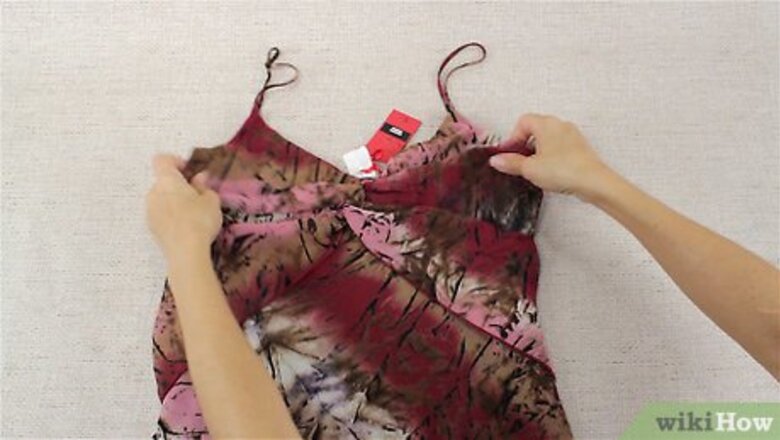
views
X
Expert Source
Mia DanilowiczMaster Tailor
Expert Interview. 8 January 2021.
It's easy to take these measurements and well worth your time.
Measuring a Dress on a Flat Surface

Lay the dress on a flat, clean surface. Before you measure the dress, choose a clean, flat surface to place it on, such as a table, bed, or a clean area of the floor. Zip up the dress first if it has a zipper and then place it onto the surface. Smooth it out so there are no bumps in the fabric. It’s especially important to make sure that the area is clean if you plan to sell the dress. Wipe off the table, put down a fresh sheet, or sweep the floor before you place the dress on it.
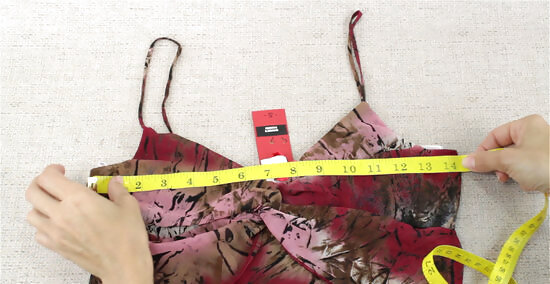
Hold the measuring tape across the fullest part of the bust and double it. Take the measurement from 1 side seam to the other right under the armholes or sleeve seam of the dress. Hold the end of the soft, flexible measuring tape at 1 side seam and pull it across the bust to the opposite side seam. Then, double this measurement to find your bust measurement for the dress. For example, if the measurement is 17 in (43 cm), then the bust measurement is 34 in (86 cm). Don't use a ruler to take your measurements. Make sure to use a soft, flexible measuring tape. If you don't have one, you can print one out and tape it together.
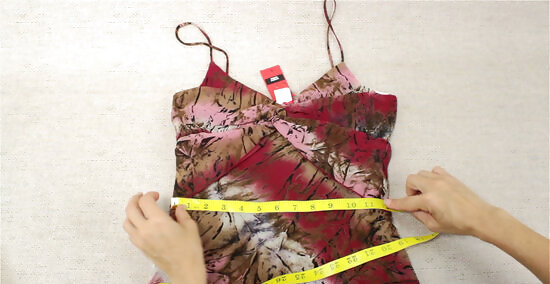
Measure the dress across the smallest part of the waist and double it. Look at the dress and find the smallest part of the waist. If the dress is fitted, then this should be easy to spot. However, if the dress fits loosely around the waist, then you might have to estimate where the waistline is. Hold the end of the measuring tape against the side seam pull it across the waist of the dress to the opposite side seam. Then, multiply this measurement by 2. For example, if the waist measures 15 in (38 cm) across on the front side of the dress, then the dress’s waist measurement is 30 in (76 cm). If the bodice and skirt of the dress are separate, then the waist may be located along the seam between these 2 pieces.
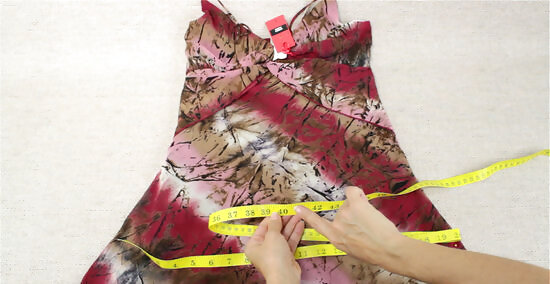
Measure across the fullest part of the hips and double it. Next, locate the part of the dress that would cover a person’s hips. This part of the dress is usually about 8 in (20 cm) below the waistline, so you can measure down from there if you’re unsure. Measure from 1 side seam to its opposite going across the hip section of the dress. Then, double this number to get the hip measurement. For example, if the measurement is 21 in (53 cm), then the hip measurement for the dress is 42 in (110 cm).
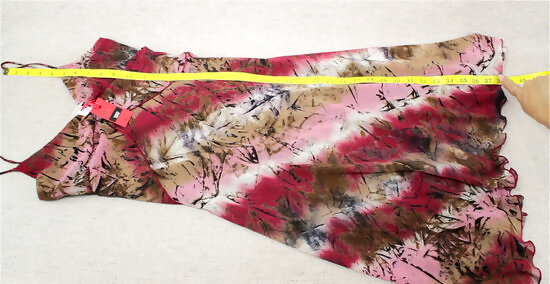
Take the measurement from the top of the shoulder to the hem. This will provide you with a total length measurement for the dress. Do not double this number. Locate the seam at the center of the shoulder or the topmost part of the shoulder strap while the dress is laying flat. Then, extend the tape measure down to the hem of the dress’s skirt. For example, if the dress measures 45 in (110 cm) from shoulder to hem, then this is the dress’s length.
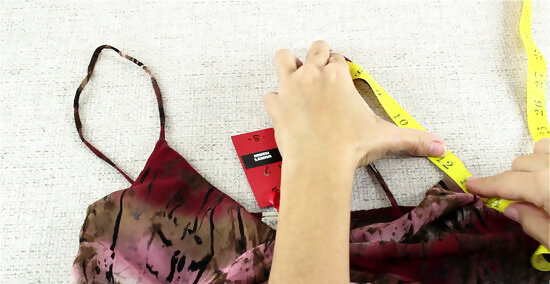
Straighten the arm out and measure from shoulder to cuff. Pull on the sleeve gently to ensure that it is fully extended out to the side of the dress. Then, place the end of the tape measure at the top part of the shoulder or along the shoulder seam. Then, measure down to the end of the sleeve. Record this number as your sleeve measurement. For example, if the dress’s sleeve measures 10 in (25 cm), then that is its sleeve length. You can skip this if the dress is strapless. However, if the dress has straps at all, then you might want to measure to find the strap width.Tip: Make sure to measure both sleeves if the dress is A-symmetrical and has different sleeve lengths.

Measure the hem and double it to find the dress’s flare. Spread out the skirt so that it is fully flared out, but laying flat with 1 layer on top of the other. Then, measure from 1 end of the hem to the other end. Double this measurement to find the dress’s flare measurement. For example, if the dress’s hem measures 25 in (64 cm) on 1 side, then the flare measurement is 50 in (130 cm)
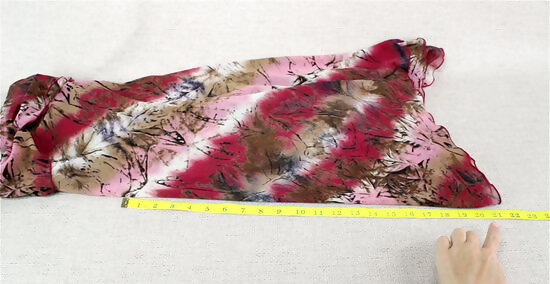
Find the waist to hem measurement to get the skirt length. Identify the waistline again and then hold the end of the measuring tape against it. Bring the measuring tape down towards the skirt and all the way to the hemline, which is the bottom edge of the skirt. Record this measurement exactly as your dress’s skirt length. For example, if the dress measures 36 in (91 cm) from the waistline to the hem, then this is the skirt length of the dress.
Measuring a Dress that Someone is Wearing
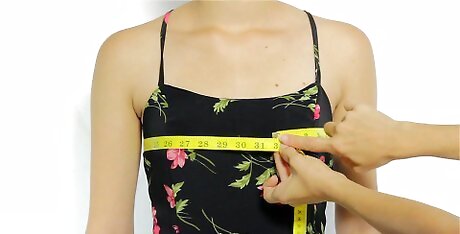
Wrap the measuring tape around the fullest part of the person’s bust. With the person wearing the dress and standing in front of you, wrap the measuring tape around the dress at the bust. Locate the fullest part of the bust to take the measurement. Record this measurement as the dress’s bust measurement. For example, if the dress measures 38 in (97 cm) around the bust, then that is the dress’s bust measurement. Don’t wrap the measuring tape around the person’s bust too loosely. Hold it so it is snug against the dress.Tip: Make sure that the dress fits well on the person who is wearing it when you measure it. Otherwise, you won’t get accurate measurements.
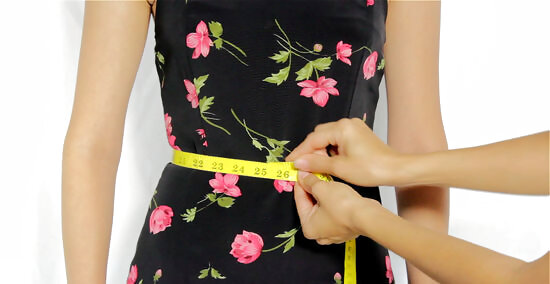
Measure around the smallest part of the person’s waist. Locate the smallest part of the person’s waist, which will be wherever the dress tapers inward. Usually this is right around or just above their belly button. Measure around this point on the dress and record the measurement exactly. For example, if the dress measures 29 in (74 cm) around the waist, then that is the dress’s waist measurement.
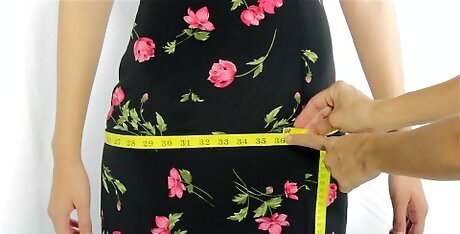
Locate the hipbones and measure around them. Find the widest part of the person’s hips where the dress is still fitted and measure around this point with the tape measure. Hold the tape measure snugly against the person’s body and record the number you get. For example, if the hips measure 48 in (120 cm), then that is the dress’s hip measurement. Note that this will not work if the dress flares out at the hips since it may also fit on someone with wider hips than the person who is currently wearing it. Only take this measurement while the person is wearing the dress if the dress is fitted through the hips.
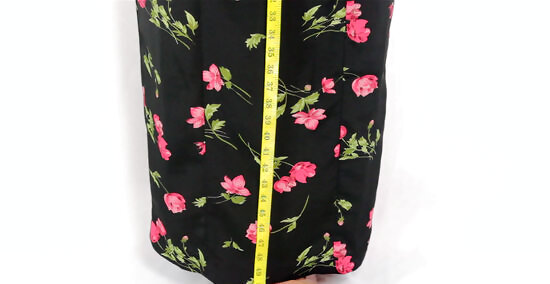
Find the hollow to hemline measurement to get the dress length. The hollow is at the base of a person’s neck. Finding the hollow to hemline measurement will enable someone who wants to buy the dress to see where it will fall on them. Measure from this point down to the hemline of the dress. Record this measurement exactly. For example, if the measurement from the hollow of the person’s neck to the hemline of the dress is 40 in (100 cm) around the bust, then that is the dress’s hollow to hemline measurement.
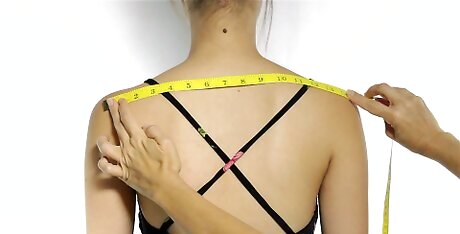
Measure from shoulder to shoulder across the back of the dress. The person may also want to know the width of the dress from shoulder-to-shoulder. Place the end of your tape measure at the topmost part of the person’s shoulder and measure across the back of the dress to their other shoulder. Record this measurement. For example, if dress measures 16 in (41 cm) from shoulder to shoulder, then that is the dress’s shoulder-to-shoulder measurement.
Find the dress’s arm length by measuring from shoulder to cuff. If the dress has sleeves, you can also take this measurement while the person is wearing the dress. Have them fully extend their arm and place the end of the measuring tape at the top of their shoulder or where the sleeve meets the shoulder. Measure down to the cuff of the sleeve and record this measurement. For example, if the sleeve measures 18 in (46 cm), then that is the dress’s sleeve measurement.













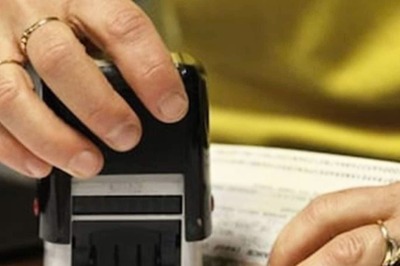


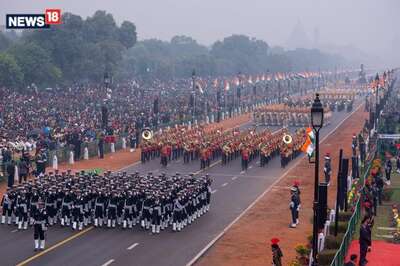

Comments
0 comment